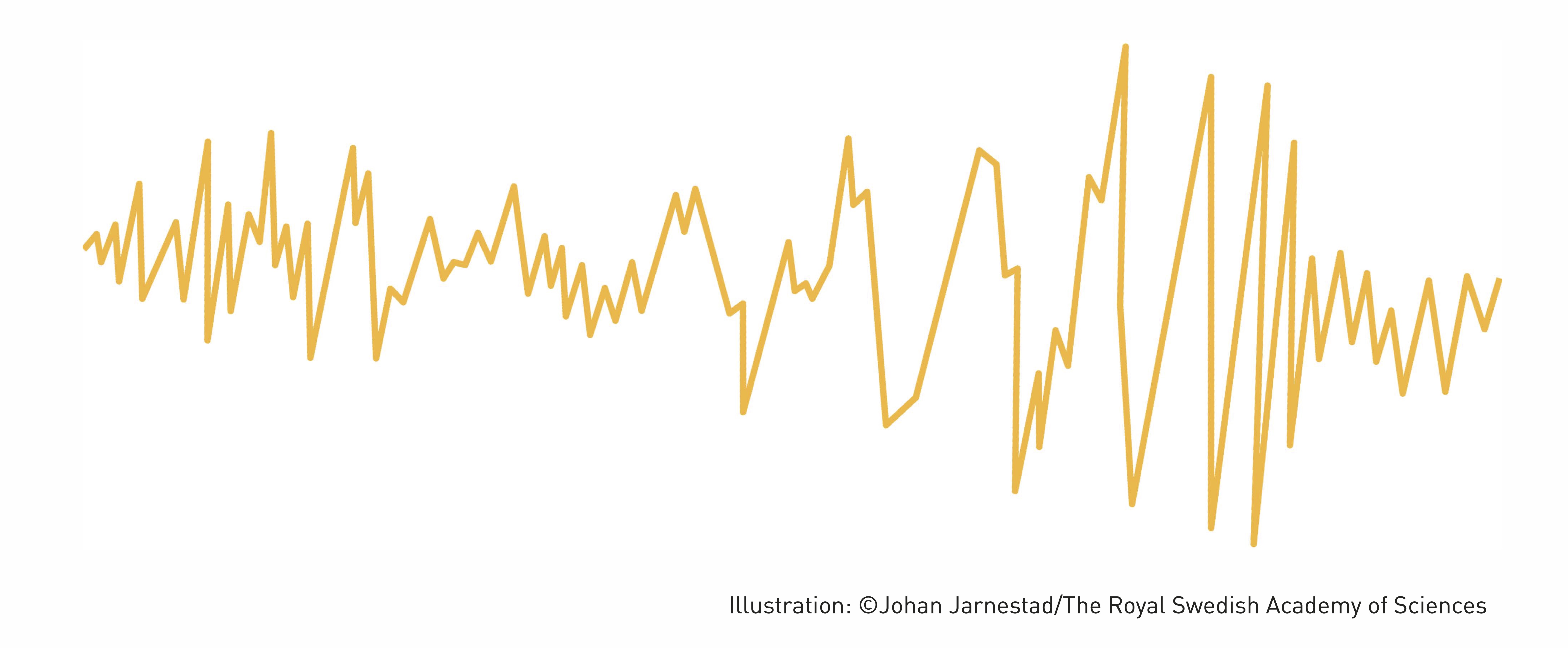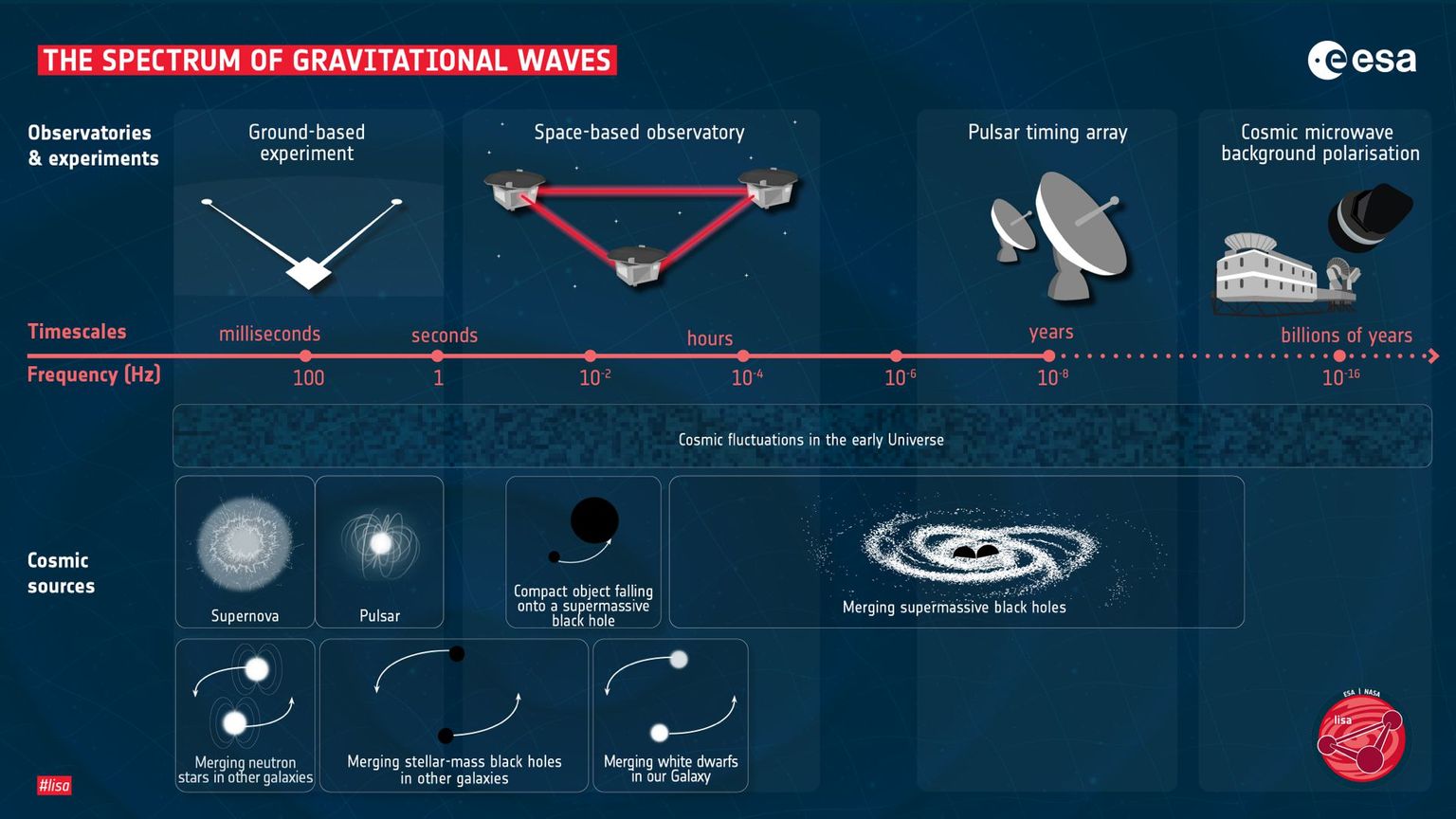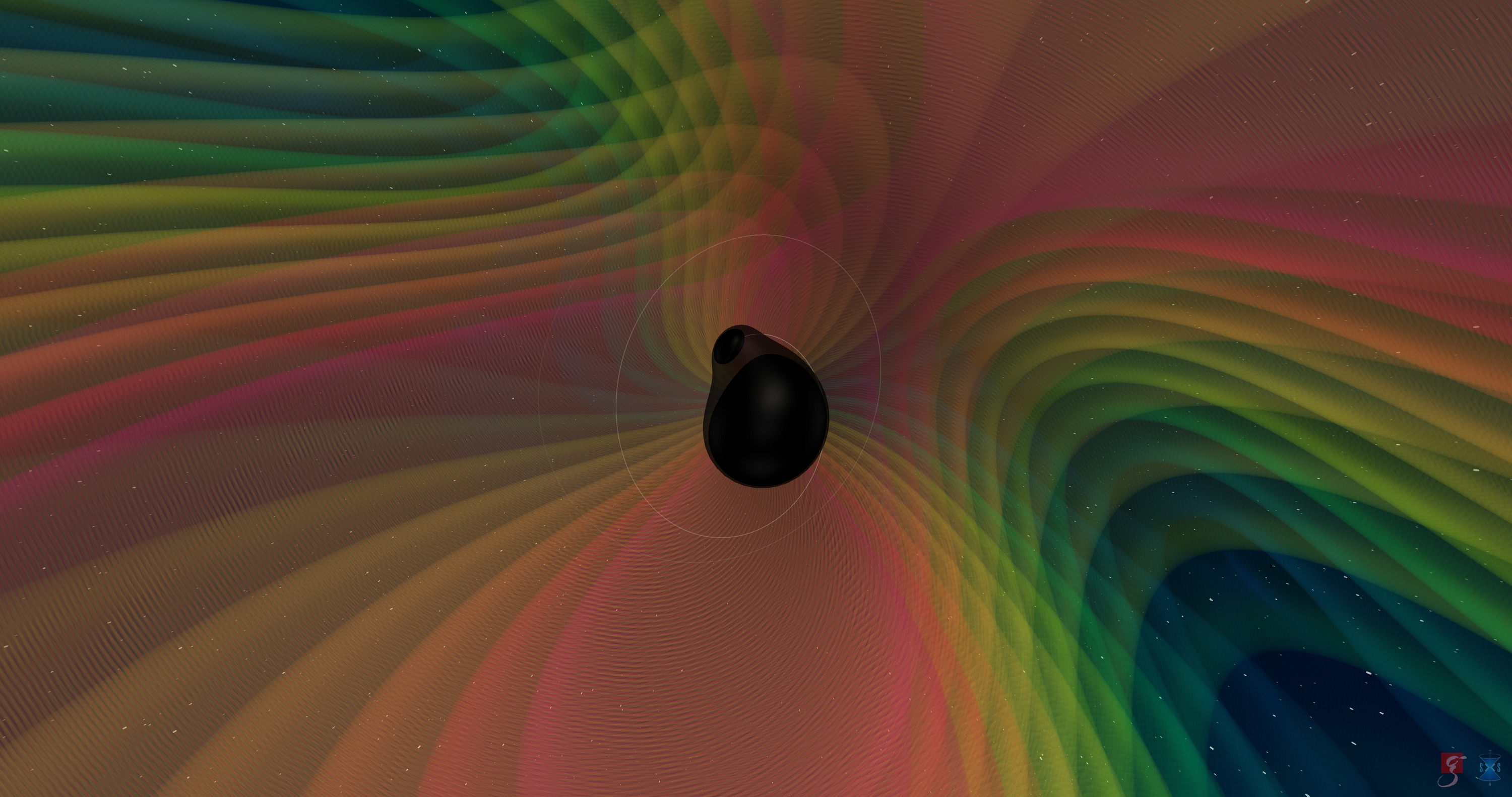Model
The Exhibit
Pressing the pedals makes the two spheres revolve. Their movement produces waves in the fabric which move outwards at a speed which depends on the stiffness of the fabric. This characteristic speed is about 10 m/s (36 km/h) and the two spheres must move at nearly that speed to produce the waves.
In this experiment we use stroboscopic lights to make all speeds appear slower: this allows us to see the waves.
Gravitational waves
The two spheres in the exhibit represent two black holes and the fabric represents space. Indeed, according to general relativity, space is something dynamically interacting with matter: the presence of matter bends space and moving matter can produce waves like in the fabric of this model.
The bending of space, represented by the curved grid on the floors, is just what we call gravity. And the waves produced by moving objects are called gravitational waves.
However, space behaves like a very stiff fabric, and every stretching and shrinking is extremely small.
-

- Artistic Image of a gravitational wave signal. Copyright © Johan Jarnestad/The Royal Swedish Academy of Sciences.
Detection
When a gravitational wave passes by, the distances between objects change in a characteristic way, predicted by theory. Through precise measurements of the distances, it is - in principle - possible to detect gravitational waves.
The strongest gravitational waves come from merging black holes and correspond to a change in the fabric of space of a part on less than a thousand million billion. This amounts to less than the size of a proton over several km.
For this reason, the detection of gravitational waves was only possible in 2015 through the LIGO-VIRGO experiments. These experiments are the result of the collaborations of more than a thousand researchers from all over the globe over the last three decades.
The LIGO detectors are located in Washington State and Louisiana in the USA, while VIRGO is installed in Tuscany in Italy. These instruments measure the difference in the light travel time over several kilometers when a gravitational wave passes by. This allows the detection of gravitational waves produced by the mergers of stellar remnants in the form of neutron stars and black holes. These waves have frequencies between 10 Hz to 1000 Hz.
In the coming years more experiments are expected to detect gravitational waves.
- Einstein Telescope (mid 2030s): a next-generation detector in Europe. It will be similar to LIGO and VIRGO but with a much higher sensitivity, which means it will be able to detect very faint signals. It is expected to detect millions of times the number of sources that are known at present.
- LISA (Laser Interferometer Space Antenna, mid 2030s): a space based gravitational wave observatory. It will consist of three coordinated spacecrafts millions of kilometers apart. It will be sensitive to sources not detectable by other methods, because of the extremely low frequency of the gravitational waves.
- Pulsar Timing Array (now observing): an array of radio-telescopes measuring the pulsed emission from spinning neutron stars (pulsars). Pulsars behave like extremely accurate natural clocks, and the measurement of coherent departures from regularity in the timing signals from many pulsars would indicate gravitational waves passing between us and the pulsars.
- Spacecraft Ranging: measuring the travel time of radio signals to and from spacecraft is an essential part of space missions. Gravitational waves would perturb these radio signals in a predictable way. Space probes to other planets, such as Juno to Jupiter and Cassini to Saturn, have searched for signatures of gravitational waves in their ranging data, but the required accuracy has not been reached yet. A proposed mission to Uranus in the 2030s with improved sensitivity may succeed in detecting gravitational waves.
-

- Different gravitational wave observatories can pick up different types of gravitational waves, i.e., waves of different frequencies over different time scales. The polarisation of the cosmic microwave background (radiation in the universe that stems from the very early universe, when the universe was just 400’000 years old) can contain signatures of the low frequency gravitational waves produces in the early stages of our universe during the inflation. Credits: ESA.
LIGO and VIRGO experiments
The LIGO and VIRGO experiments consist in large interferometers (each arm is about 4 kilometers long) situated underground. Interferometers are instruments that use the interference of two beams of laser light to make the most precise distance measurements in the world. This animation shows the way these instruments work in a simplified way [credits: T. Pyle, Caltech/MIT/LIGO Lab].
A beam of laser light is split into equal beams that travel in perpendicular directions in each of the two arms of the experiment. At the end of each arm there is a mirror reflecting the laser light back. After traveling back, the two laser beams are recombined again (i.e., they interfere) on a detector. If the length of the arms is identical, the recombined signal will produce a characteristic pattern on the detector. However, if a gravitational wave passes by the lengths of the two arms of the instrument change in a characteristic way: this results in a different interference pattern when the two light beams are recombined. By comparing the variations of the pattern with expected simulated signal, scientists can understand when a gravitational wave passes by and retrieve information about its source. Notice that the effects of the gravitational waves have been vastly exaggerated in this video to demonstrate how the instrument works. In reality, the changes in the lengths of the instrument's arms are less than the size of a proton over several kilometers.
LISA Mission
In this video Prof. Philippe Jetzer explains how LISA, the first gravitational wave observatory in space, works. The LISA project is led by ESA with contributions of NASA and is scheduled to launch to Space in 2036. Its detection of gravitational waves should help to gain knowledge about e.g., evolvement of galaxies and theory of general relativity. Professor Jetzer from the Department of Physics of the University of Zurich is the Swiss representative in the LISA Science Study Team of ESA. Thales Alenia Space built the front-end electronics for the LISA Pathfinder satellite, which was launched in December 2015 and successfully tested several technological components that will be needed for LISA.
Sources of gravitational waves
Any massive body that is accelerating produces gravitational waves. But the gravitational waves produced by an accelerating car - for example - are much too weak to be measured. The strongest gravitational waves are generated by pairs of mutually orbiting objects which themselves have extremely large gravitational fields.
Notable among these are the following:
- Stellar mass black hole: a remnant of a massive star, having many times the mass of the Sun but a size of only tens of kilometers. It curves space so dramatically that nothing, including light, has enough energy to escape it.
- Super-massive black hole: A giant relative of the above, with a mass millions of times that of the Sun. The centre of the Milky Way hosts a supermassive black hole, as do indeed the centres of most galaxies.
- Neutron Star: a stellar remnant that is just short of becoming a black hole, where matter has been squeezed by its own gravity into a quantum substance that behaves like a single humongous neutron. For example, a neutron star with about 1.4 solar masses is so strongly compressed that it only has a diameter of 11 km.
- White Dwarf: a less extreme stellar remnant, formed from a Sun-like star that has consumed all its hydrogen fuel and shrunk to a size comparable to the Earth.
-

- Simulation of a black hole merger with asymmetric masses and orbital precession, consistent with GW190412. Credits: N. Fischer, H. Pfeiffer, A. Buonanno (Max Planck Institute for Gravitational Physics), Simulating eXtreme Spacetimes (SXS) Collaboration.
Nobel Prize 2017
The detection and analysis of the information carried of gravitational waves opens a new era for astrophysics, allowing scientists to study the universe in a completely new way, and shedding for the first time light on previously unseeable phenomena.
For this remarkable achievement Barry C. Barish, Kip S. Thorne and Rainer Weiss, three key LIGO co-founders, have been awarded the Nobel Prize for Physics in 2017.
According to Kip Thorne: "The prize rightfully belongs to the hundreds of LIGO scientists and engineers who built and perfected our complex gravitational-wave interferometers, and the hundreds of LIGO and Virgo scientists who found the gravitational-wave signals in LIGO's noisy data and extracted the waves' information, it is unfortunate that, due to the statutes of the Nobel Foundation, the prize has to go to no more than three people, when our marvelous discovery is the work of more than a thousand."
